Sacha Dent, 39, checked the weather before packing up her bag, preparing for a treasure hunt that could end in a prize of an estimated $2 million. Looking at the radar, checking wind direction, precipitation levels and humidity, Dent took it all into account for her 300 trips into New Mexico's wilderness. After following the temperatures in the mountains for weeks, making sure the ground had thawed out but that the snowmelt wasn't flooding the creeks, she went out to investigate her theory of needing a sunny day to cast her shadow on the hidden treasure.
For more than a decade, treasure estimated to be worth at least $2 million sat tucked away in a crevice of the Rocky Mountains, its location known only to one man until a new pair of eyes glanced quickly down.
Forrest Fenn, an art collector and millionaire, had been diagnosed with kidney cancer in the late 1980s, and doctors' prognosis gave him little chance of beating it. Fenn loaded some of his antiquities on hand into an ornate, antique bronze lockbox of Romanesque design, locking gold, jewels and other artifacts inside. He had originally planned to have his remains interred with the treasure, to be hidden until someone stumbled upon them both, according to The California Sunday Magazine.
Then, against all odds, Fenn beat the cancer. Still, the thought of a treasure hunt stuck. In 2010, Fenn self-published a memoir, The Thrill of the Chase, including a cryptic poem with the promise of treasure at the end.
And so began the chase.

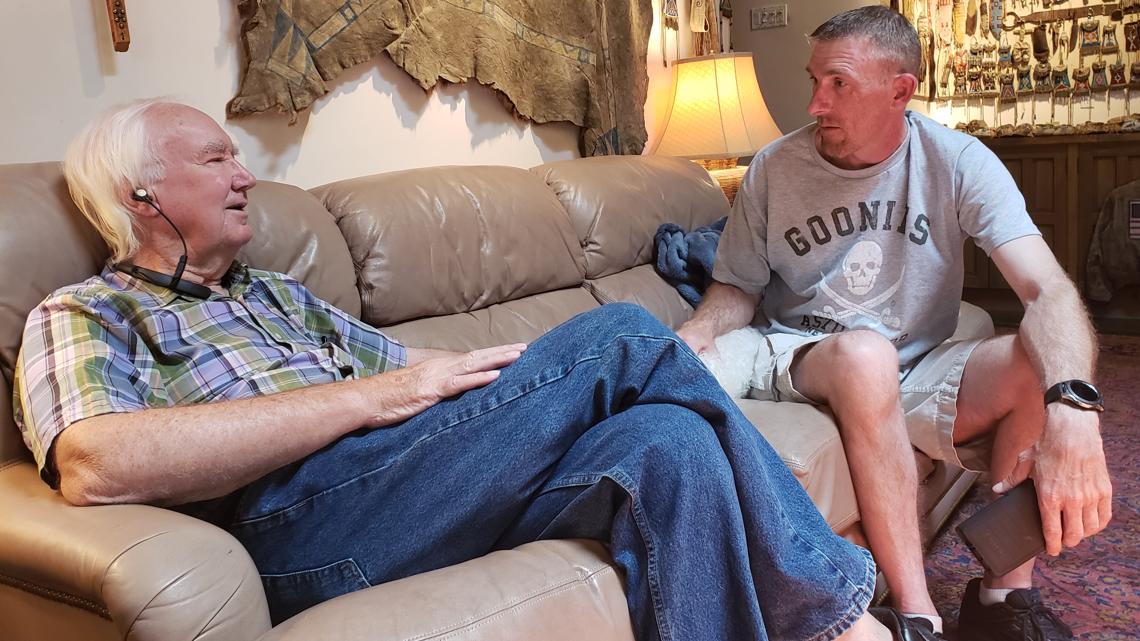
A vague direction of where to look for the treasure (and where not to look) was given as a starting point, along with the line in the poem "Begin it where warm waters halt." Fenn revealed the treasure was somewhere in the Rocky Mountains, between Santa Fe and the Canadian border at an elevation of above 5,000 feet. The treasure would also not be located in a mine, a graveyard or near a structure.
The public reception to the memoir resulted in thousands flocking to the mountains as news stations picked up on the hunt. Interviews with Fenn inspired thousands to take to the mountains, fulfilling his goal of "getting people off their couches," and discovering the outdoors.
The glamour of the chase, however, was soon marred by the dangers that came with exploring the Rockies. As recently as March 2020, two snowmobile riders from Colorado became stranded in a Utah park, where one died in search of the treasure, according to CBS News.
The two had been searching for the treasure near Dinosaur National Monument along the Utah-Colorado border. This was the second time a rescue team had been deployed to help the two snowmobile riders when they'd been out searching for the treasure, according to The Washington Post.
"What happened was tragic," Fenn told CBS News in an email about the fate of the Colorado men.
"You have lightning, bears, cliffs, thermal areas. Lodgepole pine trees aren't known for staying standing -- they come down easy," backcountry guide Jim Holstein with Yellowstone Tour Guide in Big Sky told The Washington Post, describing the dangers around the park that other treasure hunters have run into. "There have been people killed by all of those methods over the years. You definitely have to be prepared and you should know what you're doing."
New Mexico police urged Fenn to halt the search in 2017 after the body of Paris Wallace, a pastor from Colorado, was found along the Rio Grande. He had been reported missing after telling his family he was going to search for the treasure. The year before, 54-year-old Colorado resident Randy Bilyeu was found dead along the same river seven months after his disappearance while searching for the treasure, according to The Guardian.
Some have even suggested that people were embarking on a quixotic adventure or a hoax with only Fenn's word as proof the treasure actually existed.
"People are coming from other states and other parts of the world to find this elusive treasure that may or may not exist, with very little clues," Chief Pete Kassetas of the New Mexico State Police said in 2017, urging Fenn to stop the hunt. "They're underestimating New Mexico."
"It is always tragic when someone dies, and this latest loss hit me very hard," Fenn said in response to the death, according to The New York Times.
"Life is too short to wear both a belt and suspenders," he said. "If someone drowns in the swimming pool we shouldn't drain the pool, we should teach people to swim."
At least three people have lost their lives in search of the treasure.
Despite the dangers of the chase, Dent, who now works in communications and public relations, was one of the thousands enticed by the call.
She first heard about it while watching a segment of NBC's Today Show in 2013, but was pregnant at the time. After saving a few online pages she had found on the treasure, she didn't think about the treasure again until several months after her son was born. In the process of transferring information from her old computer to a new one, Dent came across the bookmarked pages. It came at a time when Fenn had just released his second book, which included a map.
"When I looked at the map, it made me think of the scene from The Goonies when they are in the attic and they accidentally break the picture and they find the treasure map in the movie," Dent told AccuWeather over a Skype interview. "Ever since then, I was just hooked. I started looking I think that week."
The spark of adventure ignited.
"Every time I went out on a treasure hunt ... it always felt the same way," Dent said. "It was always excitement for the unknown and what I could discover on that day. So for me, that sense of adventure I think was just born into me as it is many others and that's what drew many people to want to participate in this incredible adventure."
A New Mexico resident, Dent stuck to searching in the state since Fenn lived in Santa Fe. Fenn was in his late 70s before publishing his first book, and he had hinted that the treasure wasn't anywhere a man his age couldn't reach on his own. For Dent, she didn't think he would go too far from his home with the treasure weighing an estimated 45 pounds. Other adventurers have theorized Fenn hid the treasure near Dinosaur National Monument or Yellowstone National Park, based on interpretations of his book.

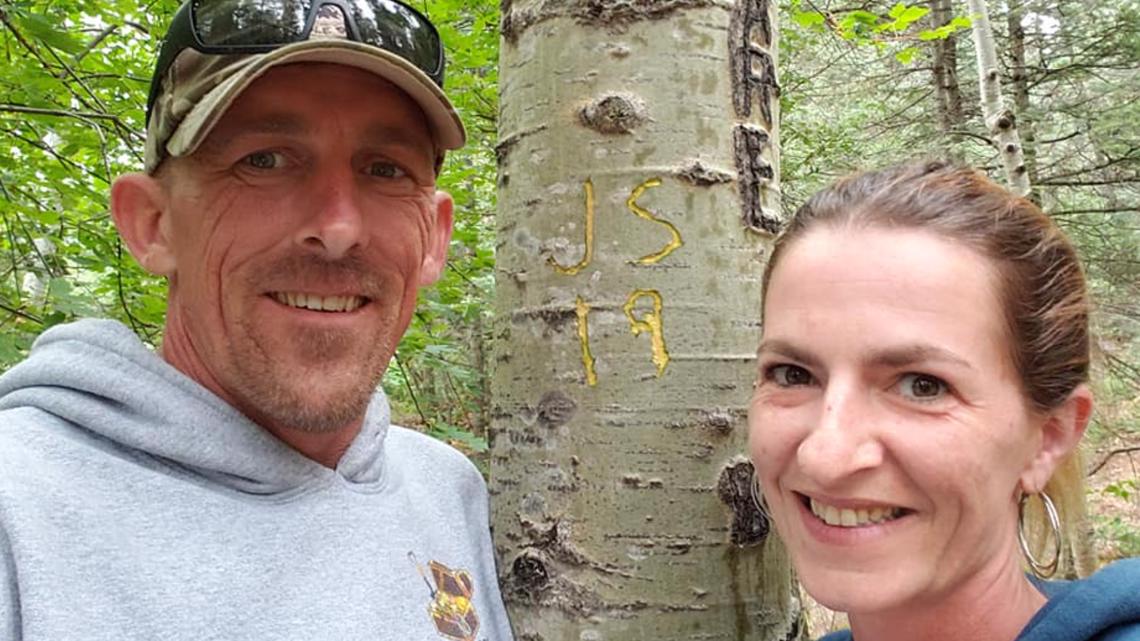
Many treasure chasers have delved into Fenn's two books, scouring them for clues and dissecting his words. From this, a variety of different interpretations were formed -- everything from where to begin the hunt to what weather elements to watch the radar for.
"Forrest Fenn gave words of advice when you look for his treasure, and one of the words of advice that he gave is that the Rocky Mountains can have instant personality reversals, and weather was just as important as any other factor in a treasure hunt," Dent said.
While out on the expeditions, she also used the birds as an indicator for any unexpected weather. She viewed the crows as sentinels since they routinely were on patrol overhead.
"One way I would notice that bad weather was coming is that none of the birds would fly, and so ... that was a big indicator," Dent recalled. "I became accustomed to seeing the crows flying above so one of the biggest and most noticeable ways you knew weather was moving in is that the birds were quiet and they weren't flying."
Storms rolling in often meant not just more difficult terrain and the threat of lightning, but the rain also led any creeks Dent had crossed to rise. If she didn't take the weather threat seriously, a swollen creek could have led to more dangerous hazards when she made her return.

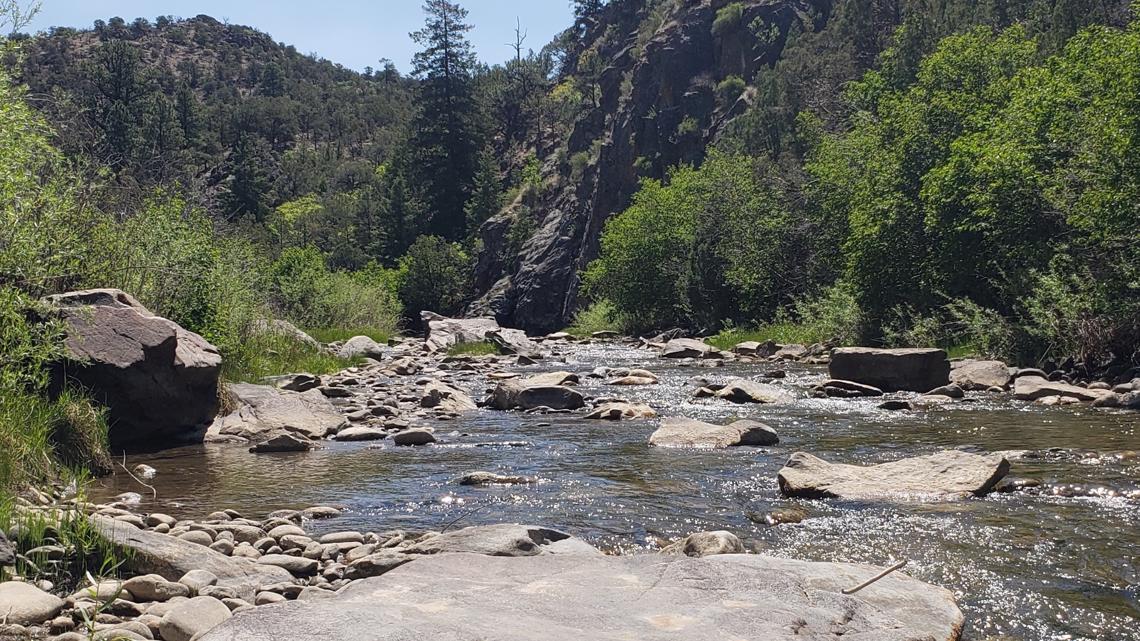
Dent developed a theory that required her to pay close attention to the weather in the mountains before going out to search. She recalled that Fenn used to say, "If you don't know where warm water is, then you should stay home and play Canasta." In the card game, a player can't pick up the discard pile when it's frozen, so Dent theorized that meant she wouldn't be able to retrieve the treasure when the ground was frozen.
While keeping a pulse on the temperatures in the area, Dent employed the use of the USGS website to gauge water levels and speed of the creeks and streams she would have to cross.
"I had to know when it was going to be warm enough that the snow thaw in the mountains above us were done so that the water levels would be lower, because in the spring the water levels are too high to cross the creek," Dent said. "And then I had to know, is all the snow melted in the area where I want to search, has it been warm enough to warm the ground?"
After using her research to meticulously plan a time frame for her search, Dent employed the use of another of her theories. This one would require a sunny afternoon.

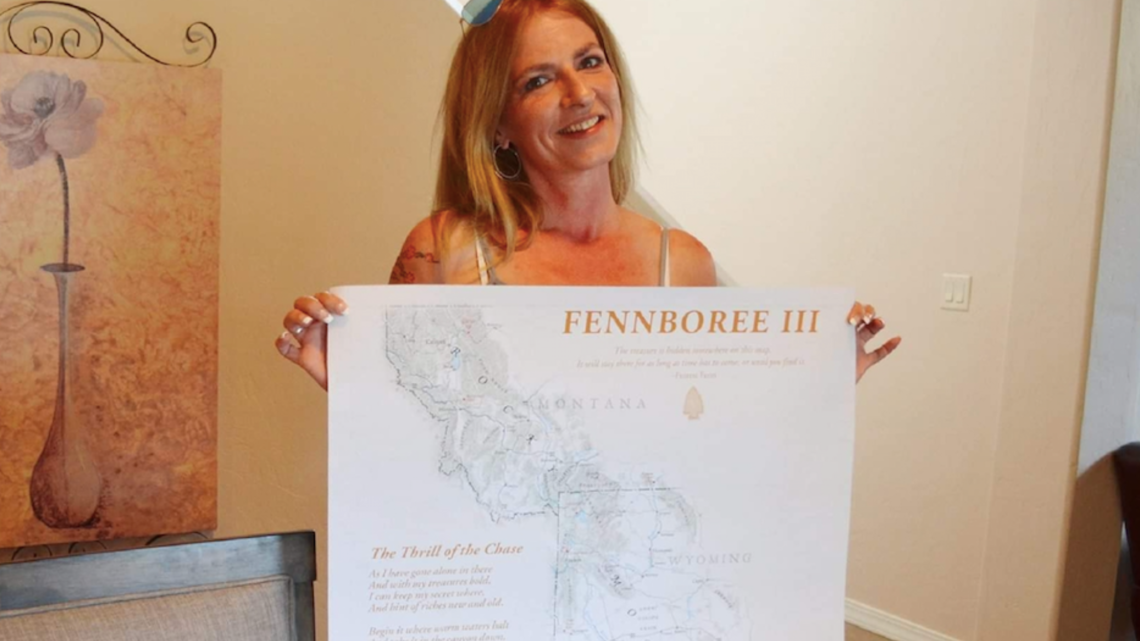
The cover of Fenn's second book, Too Far to Walk, portrays a shadow of an adventurer cast over flowing water. Dent interpreted this as a new clue.
"I believed at the end of the afternoon, your back to the afternoon sun would cast your shadow to a specific location and would let you know that's the area where the treasure was hidden," Dent said.
On June 6, 2020, Fenn confirmed that the decade-long treasure hunt had come to its conclusion.
Fenn told the Santa Fe New Mexican that the man who found the riches did not want to be named, but was from "back East" and had sent in a photo of the treasure as confirmation.
"It was under a canopy of stars in the lush, forested vegetation of the Rocky Mountains and had not moved from the spot where I hid it more than 10 years ago," Fenn said on a blog post. "I do not know the person who found it, but the poem in my book led him to the precise spot. I congratulate the thousands of people who participated in the search and hope they will continue to be drawn by the promise of other discoveries. So the search is over."
Fenn posted three photos of the treasure on his blog Tuesday, June 16.
"The treasure chest was found by a man I did not know and had not communicated with since 2018," Fenn wrote. "The finder wants me to remain silent and I always said the finder gets to make those two calls. Who and where."
The end of the hunt came with a mix of emotions from the people involved, from relief to disbelief and frustration to a yearning for a new adventure.
"We are very happy," Dan Johnson, spokesman for Dinosaur National Monument, told The Washington Post. The park had been a place of multiple rescues during the search.
For Dent, the realization hit hard.
"When I heard the treasure had been found, I went through a lot of emotions like a lot of people," she said. "We heard on Saturday night, and so Saturday night there was shock and almost disbelief, and then on Sunday, there was a lot of sadness because the adventure's over."
Come Monday, Dent said, excitement grew once more as she began to look for new opportunities to search for lost treasure.

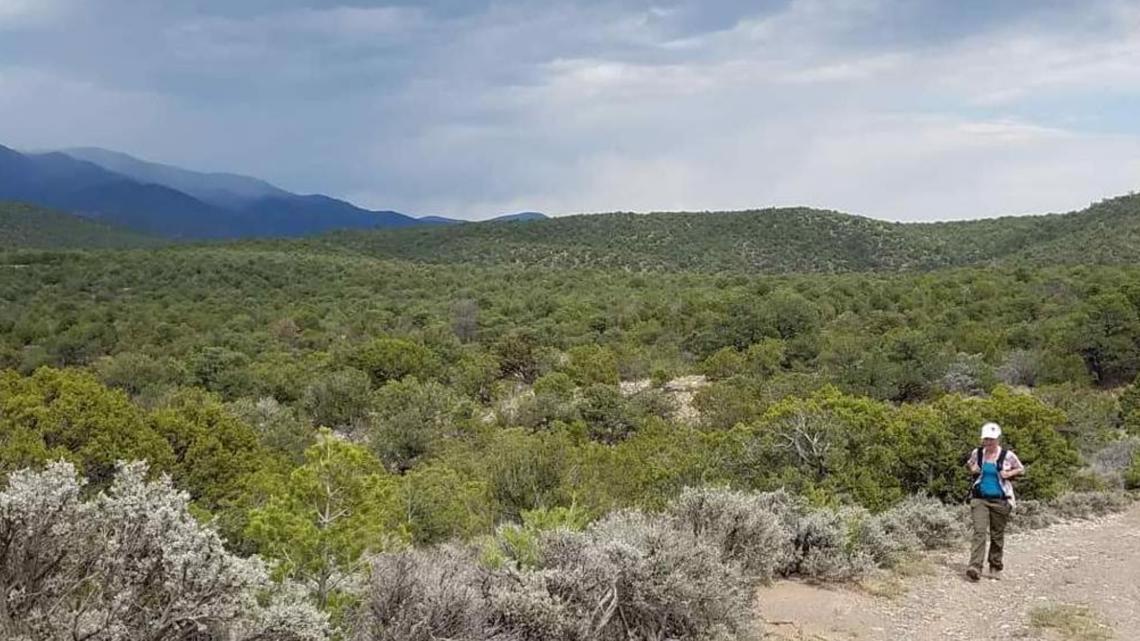
"That unknown and that excitement of what's the next adventure is pretty thrilling," Dent said. As for the last hunt, she doesn't want Fenn to release the location, stating nothing good can come from knowing it. People would feel awful if they found out they had been looking in the right location only to let it slip through their fingers, or to find out that they were no where near solving the poem and never stood a chance.
"I don't think any good can come from knowing the location of where the treasure chest was found," Dent said. "So long as the location's never realized, all of us who searched for the treasure get to believe that we were right in our own minds. That we had that chance, that we were a contender, and for some of us, that's as good as it's going to get."

